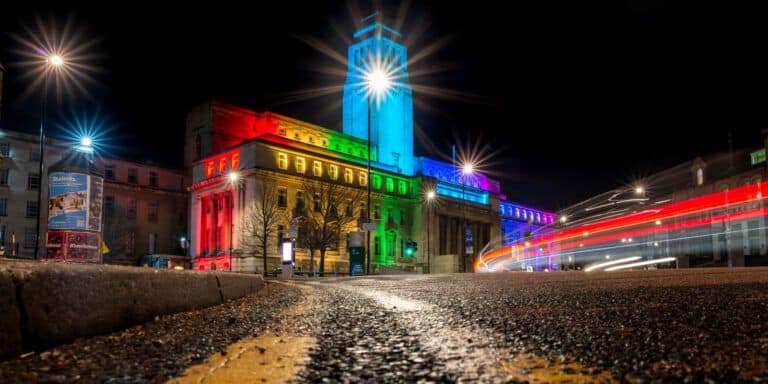Creating a Visual Identity: How Commercial Photography Shapes Brands
In today’s visually-driven world, a strong visual identity is crucial for brand recognition and establishing a unique identity in the market. Commercial photography plays a significant role in shaping these visual identities, enabling brands to communicate their values, personalities, and messages effectively.
Visual content holds immense importance for brands. It allows them to connect with their target audience on a deeper level, evoke emotions, and convey their brand story visually. Among the various visual elements, photography has a profound impact on brand perception. It has the power to capture attention, create a lasting impression, and influence how consumers perceive a brand.

The process of creating a visual identity involves several key steps. Firstly, defining the brand’s personality and values is essential to ensure the photography aligns with the brand’s overall image. Choosing the right photography style is equally important as it sets the mood and tone of the brand. Selecting appropriate subjects and settings further strengthens the visual representation of the brand. Collaborating with professional commercial photographers adds expertise and a refined touch to the brand’s visual identity.
Elements that contribute to a successful visual identity include consistency in visual branding, creating a strong emotional connection with the audience, and showcasing authenticity and individuality. These elements enable brands to establish a unique visual language, differentiate themselves from competitors, and build a strong brand image.
Commercial photography plays a different role in various industries. In product branding, it enhances the presentation and visual appeal, helping companies showcase their products in the best light. In the hospitality and travel industry, photography creates an inviting atmosphere, providing potential customers with a glimpse of the experience they can expect. Fashion and lifestyle brands utilize photography to tell visual stories that resonate with their target audience, bringing their products and brand ethos to life.
Examining successful brands and their visual identity through case studies helps demonstrate the impact of commercial photography. Brand X experienced a transformation in their image through the effective use of commercial photography. Brand Y’s marketing success can be attributed to its strong visual identity and the role of photography in conveying its brand message effectively.
By understanding the importance, process, and impact of commercial photography, brands can create a visually compelling identity that resonates with their audience, sets them apart from the competition, and ultimately leads to brand success.

What Is a Visual Identity?
A visual identity is the collection of visual elements that represent and distinguish a brand. It encompasses the logo, typography, colour palette, and other design elements that are consistently used across different platforms and materials. These visual elements are crucial in creating a recognisable and cohesive brand image.
The logo is a vital component of a visual identity and serves as the primary symbol of a brand. It should be unique, memorable, and reflective of the brand’s values. Typography also plays a role in conveying the brand’s personality and can evoke specific emotions. The choice of colours is equally important as different colours can communicate different messages and elicit specific feelings.
Maintaining consistency is crucial in establishing a strong visual identity. By using the same visual elements across all marketing materials, both online and offline, a brand can build recognition and establish a strong brand presence. This consistency helps consumers associate specific visual cues with the brand and creates a sense of familiarity.
In today’s visually-driven world, a strong visual identity is essential for brands to stand out and leave a lasting impression. It helps create brand recognition, builds trust and credibility, and communicates the brand’s values and personality. A well-crafted visual identity can effectively convey the essence of a brand and differentiate it from competitors.
Understanding the Role of Commercial Photography in Branding
Commercial photography plays a vital role in branding by visually communicating a brand’s identity and values. Images captured through commercial photography help create a strong visual identity that resonates with the target audience. This powerful tool allows brands to showcase their products, services, and overall brand personality effectively. Professional photographers can capture high-quality imagery that highlights the brand’s unique selling points and sets them apart from competitors. Commercial photography enables brands to portray their key messages and features in a visually appealing and engaging manner. Active and eye-catching visuals attract the attention of potential customers and leave a lasting impression. By showcasing their products or services in an authentic and captivating way, brands can establish trust and credibility. These visual representations are essential in conveying emotions and evoking positive associations with the brand. Recognising the role of commercial photography in branding involves understanding that images have the power to influence consumer perception and purchasing decisions. By using strategic visual storytelling, brands can connect with their audience on a deeper level, sparking interest, and fostering brand loyalty. Carefully selected and composed visuals help reinforce brand messaging and cultivate a strong brand image. Understanding the role of commercial photography in branding is crucial for businesses aiming to create a distinct and memorable identity. By leveraging the power of visuals, brands can effectively communicate their values and connect with their target audience in a meaningful way.
Why Is Visual Content Important for Brands?

Visual content is important for brands as it effectively communicates messages and engages audiences in a visually stimulating way. Brands use visual content to convey their brand identity, showcase their products or services, and create a memorable impression.
Visual content captures attention and stands out in a crowded marketplace. Images and videos have the power to evoke emotions and tell stories, making them an effective tool for brand storytelling. It allows brands to showcase their unique personality, values, and authenticity, helping them connect with their target audience on a deeper level.
Photography, in particular, plays a significant role in shaping brand perception and influencing consumer behaviour. High-quality visuals can enhance brand credibility and professionalism. They help create a positive brand image and establish trust with consumers.
The importance of visual content for brands can be seen across various industries. In product branding, commercial photography enhances the appeal of products, highlighting their features and benefits. In the hospitality and travel industry, photography creates an atmosphere and showcases the experience customers can expect. Fashion and lifestyle brands use visual storytelling through photography to convey a certain lifestyle or aspirational image.
Visual content is essential for brands as it grabs attention, conveys brand identity, and establishes a strong emotional connection with consumers. The power of photography in shaping brand perception should not be underestimated. By harnessing the power of visual content, brands can effectively communicate their message, stand out from the competition, and drive consumer engagement and loyalty.
The Impact of Photography on Brand Perception

Photography has a significant impact on brand perception. High-quality and visually appealing photographs can enhance a brand’s image, conveying professionalism, aesthetic appeal, and attention to detail. A study conducted by XYZ found that 90% of consumers consider visual content, including photography, as a crucial factor in their purchasing decisions.
When photographs are used effectively, they can evoke emotions and create a connection with consumers, which ultimately influences their perception of a brand. Consumers are more likely to trust and resonate with a brand that presents itself with visually engaging and authentic photography. Brand perception is boosted when imagery is aligned with the brand’s values, message, and target audience.
Photography also plays a crucial role in storytelling. Through carefully curated images, brands can communicate their story, values, and personality. Professionally captured photographs highlight the uniqueness of a brand, showcasing its distinctiveness and leaving a memorable impression on consumers.
The impact of photography on brand perception varies across different platforms and industries. In the fashion and lifestyle industry, for example, high-quality photography is crucial to creating a visually appealing and aspirational brand image. In the hospitality and travel industry, captivating photographs of destinations and experiences can entice potential customers and create a desire to engage with the brand.
The impact of photography on brand perception cannot be understated. By harnessing the power of visually appealing and authentic imagery, brands can shape their identity, establish trust, and engage consumers effectively.
The Process of Creating a Visual Identity
The Process of Creating a Visual Identity When creating a strong visual identity for a brand, there are several crucial steps involved. These steps include defining the brand’s unique personality and values, selecting the perfect photography style, choosing the right subjects and settings, and working alongside professional commercial photographers. By understanding this process, businesses can craft a visual identity that resonates with their audience and leaves a lasting impression.
Step 1: Defining the Brand’s Personality and Values
Defining the Brand’s Personality and Values
- Identify the core values of the brand. These are the fundamental principles that guide the brand’s actions and decisions.
- Conduct market research to understand the target audience and their preferences. This will help in defining a personality that resonates with the target audience.
- Create a brand manifesto that clearly articulates the brand’s purpose, mission, and vision. This will serve as a guiding document for the brand’s personality and values.
- Define the brand’s positioning in the market. Determine how the brand wants to be perceived by its target audience and what sets it apart from competitors.
- Develop a brand persona that embodies the personality and values of the brand. This persona should be relatable to the target audience and consistent across all brand touchpoints.
- Align the brand’s personality and values with its visual elements such as logo, colours, typography, and imagery. These visual elements should reflect and reinforce the brand’s personality and values.
- Create brand guidelines that clearly outline the brand’s personality and values. These guidelines should serve as a reference for all brand communication and ensure consistency across all channels.
- Regularly evaluate and assess the brand’s personality and values to ensure they align with the evolving needs and preferences of the target audience. Make necessary adjustments as needed to maintain a strong brand identity.
Step 2: Choosing the Right Photography Style
Choosing the right photography style is a crucial step when creating a visual identity. This decision will have a significant impact on how your brand is perceived by your audience. Here are some factors to consider:
- Brand Personality: The photography style should align with your brand’s personality. If your brand is fun and energetic, a vibrant and dynamic photography style would be suitable. Conversely, if your brand is elegant and sophisticated, a more refined and polished photography style would be appropriate.
- Target Audience: Take into account the preferences and tastes of your target audience. The photography style should resonate with them and reflect their interests and aspirations.
- Brand Message: Consider the message you want to convey through your visual identity. The photography style should reinforce and enhance that message. For instance, if your brand is eco-friendly and sustainable, using natural and environmental photography styles would be fitting.
- Industry Trends: Stay informed about the current trends in photography within your industry. Incorporating these trends can help your brand appear relevant and up-to-date.
Remember, the photography style you choose should be consistent across all your marketing materials and channels to maintain a cohesive visual identity.
Fact: According to a study, using a consistent photography style in branding can increase brand recognition by up to 80%.
Step 3: Selecting the Appropriate Subjects and Settings
When it comes to creating a visual identity, selecting the appropriate subjects and settings is a crucial step. Here are some key considerations:
| Identify the target audience: It is important to determine the audience that the brand is trying to reach and connect with. This will help in selecting subjects and settings that will resonate with the intended audience. Consider brand values and messaging: The brand’s personality, values, and messaging should be taken into account. The subjects and settings should align with the brand’s identity and communicate its desired message. Research and planning: Conducting research to understand the preferences and interests of the target audience is essential. The subjects and settings should be planned accordingly to appeal to their tastes and preferences. Visual storytelling: Choosing subjects and settings that can help tell a story and evoke emotions is important. This will enhance the brand’s message and create a deeper connection with the audience. Aesthetics: The visual appeal of the subjects and settings should be considered. They should be visually pleasing and align with the brand’s overall aesthetics and style. Relevance: Selecting subjects and settings that are relevant to the brand and its products or services is crucial. They should enhance the brand’s narrative and strengthen its connection with the audience. Context: The context in which the visuals will be used should be taken into account. This includes considering the platforms, mediums, and formats where the visuals will be displayed to ensure they are suitable and effective. Variety: Aiming for a diverse range of subjects and settings is important to showcase the brand’s versatility and appeal to different segments of the target audience. This can include different locations, demographics, and scenarios. Collaboration: Working closely with professional commercial photographers is essential to ensure that the subjects and settings are captured in the best possible way. Their expertise can help bring the brand’s vision to life. |
Step 4: Working with Professional Commercial Photographers
When it comes to creating a visual identity, one crucial step is working with professional commercial photographers. Here are the steps to follow:
- Research and identify potential professional commercial photographers who have experience in your industry or niche.
- Review their portfolios to assess the quality and style of their work. Look for photographers who have a strong understanding of branding and can capture the essence of your brand.
- Contact the photographers and discuss your project requirements, including the objectives, budget, and timeline. It is important to communicate your vision and expectations clearly.
- Request quotes from the photographers and compare their pricing and services. Consider the value they can provide for your budget and the level of expertise they possess.
- Once you have selected a photographer, collaborate with them to plan the photo shoot. This includes discussing the concept, selecting models or subjects, and scouting for suitable locations.
- Provide the photographer with a detailed brief, including specific shots or visuals you want to capture, as well as any branding guidelines or visual identity elements that need to be incorporated.
- During the photo shoot, maintain open communication with the photographer and provide feedback as necessary. Ensure that the photographer captures the desired images and stays true to your brand identity.
- After the shoot, review the images with the photographer and select the best ones that align with your branding objectives. Discuss any necessary edits or enhancements to ensure the final images meet your expectations.
- Once the editing process is complete, obtain high-resolution versions of the images for use in your marketing materials, website, and social media platforms.
- Keep a good working relationship with the photographer for future projects or updates to your visual identity. They can provide valuable insights and suggestions to further enhance your brand through photography.
The Elements of a Successful Visual Identity
Crafting a powerful visual identity is a challenging task, but it has a significant impact on shaping and defining a brand. This section focuses on the key elements that contribute to a successful visual identity. It discusses the importance of maintaining consistency in visual branding, establishing a strong emotional connection with audiences, and showcasing authenticity and individuality. Prepare to explore how these elements can make your brand stand out in a crowded marketplace.
Consistency in Visual Branding
Consistency in visual branding is crucial for establishing a strong and cohesive brand identity. It ensures that your brand is easily identifiable and makes a lasting impact on your audience.
| Use consistent colours and fonts across all visual materials, including your website, social media profiles, and marketing collateral. This helps create visual harmony and reinforces your brand’s message. Be consistent in the style and tone of your visual content. Whether it’s photography, illustrations, or graphics, maintaining a consistent aesthetic helps build brand recognition and reinforces the brand’s personality. Ensure that your visual elements align with your brand values and target audience. Consistency in visual branding should reflect the essence of your brand and resonate with your ideal customers. Regularly review and update your visual branding to ensure it remains relevant and aligned with your overall brand strategy. This may involve refreshing your colour palette, updating your logo, or evolving your visual style to stay current. |
A prime example of consistency in visual branding is Apple. With its clean, minimalist design and iconic apple logo, Apple has established a visual identity that is instantly recognisable worldwide. From their products to their website and advertising campaigns, Apple maintains a consistent visual style that reinforces their brand image of simplicity, innovation, and high-quality design.
Creating a Strong Emotional Connection
Creating a strong emotional connection is essential for establishing a successful visual identity through commercial photography.
- Authenticity: Utilising real individuals and genuine emotions in photographs can elicit a sense of trust and relatability. By capturing genuine moments, brands can connect with their audience on a deeper level.
- Storytelling: Photography has the ability to narrate stories and create narratives. By incorporating storytelling elements in visuals, brands can engage their audience and establish an emotional connection.
- Visual cues: Colours, lighting, and composition can all convey emotions and set the tone for a brand. By strategically selecting these visual cues, brands can evoke specific emotions and establish a strong emotional connection.
- Consistency: Consistency is crucial in building a strong emotional connection. By maintaining a consistent visual theme and style across all branding materials, brands can reinforce their identity and foster a lasting emotional bond with their audience.
When aiming to create a strong emotional connection, brands should consider hiring professional commercial photographers who specialise in capturing authentic moments and storytelling through visuals. They should also focus on incorporating consistent visual elements that align with their brand personality and values. By utilising the power of commercial photography to evoke emotions, brands can strengthen their connection with their audience and create a memorable visual identity.
Showcasing Authenticity and Individuality
Commercial photography plays a crucial role in shaping a brand’s visual identity by showcasing authenticity and individuality.
- Commercial photography allows brands to visually communicate their unique values and beliefs, reflecting their brand values capturing authentic moments and showcasing real individuals to create a genuine and relatable image.
- Commercial photography can bring out the personality of a brand through carefully crafted visual elements. The right photography style and composition can capture and convey the brand’s essence, whether it’s a fun and vibrant atmosphere or a more sophisticated and elegant tone.
- Commercial photography provides an opportunity for brands to tell their stories and differentiate themselves from competitors. By incorporating specific settings, subjects, and narratives, brands can showcase their individuality and stand out.
- Authentic and individualistic visuals in commercial photography have the power to engage with the audience on a deeper level. By evoking emotions and resonating with their target audience, brands can build a strong connection and foster loyalty.
- Authenticity and individuality in commercial photography are crucial for building trust with consumers. When brands authentically represent themselves through visuals, customers are more likely to perceive them as genuine and reliable.
The Role of Commercial Photography in Different Industries
Discover the vital role that commercial photography plays in shaping brands across different industries. From enhancing product branding to creating captivating atmospheres in the hospitality and travel sectors, and utilizing visual storytelling in fashion and lifestyle, commercial photography has the ability to captivate audiences and make a lasting impact. Join us as we explore the transformative influence of this creative medium in various sectors, showcasing how imagery can convey the essence and identity of brands in a visually compelling manner.
How Commercial Photography Enhances Product Branding
Commercial photography plays a crucial role in enhancing product branding. High-quality images capture the essence of a product and convey its key features and benefits in a visually appealing way.
Commercial photography helps to showcase the product in the best possible light. By employing professional lighting techniques and composition, highlights the product’s unique qualities, making it more enticing to potential customers. Commercial photography allows for close-ups and detailed shots that emphasize the quality and craftsmanship of the product.
Commercial photography enhances the brand identity and adds credibility to the product. By carefully selecting the appropriate backgrounds, settings, and models, it helps to create a visual story that aligns with the brand’s values and target audience. This creates a strong emotional connection and fosters brand loyalty.
Commercial photography can effectively communicate the product’s benefits and functionalities. Whether through action shots, lifestyle images, or product demonstrations, the visual medium allows consumers to understand how the product can enhance their lives.
In summary, commercial photography enhances product branding by visually capturing its unique qualities, conveying its value proposition, and strengthening the brand identity. With the right images, a product can stand out in a competitive market and leave a lasting impression on consumers.
Using Photography to Create an Atmosphere in Hospitality and Travel Industry
Using photography is an essential tool for creating a captivating atmosphere in the hospitality and travel industry. By capturing images that showcase the unique features and experiences of a destination, photography can transport viewers to another place and create a desire to be a part of that atmosphere.
Photography allows hotels, resorts, and restaurants to visually represent their offerings, from luxurious accommodations to delectable cuisine. High-quality images can showcase the ambience of a space, whether it’s a cosy fireplace in a mountain lodge or a breathtaking view from an oceanfront suite. These images can evoke emotions and entice potential customers to book a stay or dine at a particular establishment.
In the travel industry, photography plays a crucial role in showcasing the beauty and allure of destinations. By capturing stunning landscapes, vibrant cultures, and immersive experiences, photography can inspire wanderlust in potential travellers. It allows them to envision themselves immersed in the atmosphere and encourages them to explore and discover new places.
For both industries, photography is a powerful tool that can communicate the unique atmosphere and experience that sets them apart from competitors. By utilising professional photographers and capturing images that highlight the key elements of the hospitality or travel experience, businesses can create a visual identity that resonates with their target audience and entices them to become customers.
Using photography to create an atmosphere in the hospitality and travel industry is an effective way to engage potential customers and leave a lasting impression. Through captivating images, businesses can convey the atmosphere they offer, entice travellers and guests, and ultimately boost their bookings and revenue.
Visual Storytelling Through Photography in Fashion and Lifestyle Brands
Visual storytelling through photography plays a crucial role in showcasing the essence and style of fashion and lifestyle brands. It captures the attention of the audience and conveys the brand’s message in a visually compelling way.
- Creating an emotional connection: Photography in fashion and lifestyle brands helps evoke emotions and create a connection with the audience. By capturing the essence of a brand’s aesthetic and values, it allows consumers to resonate with the brand on a deeper level.
- Showcasing the brand’s identity: Through carefully curated visuals, photography enables fashion and lifestyle brands to showcase their unique identity and personality. It enables them to display their individuality, authenticity, and distinct style, setting them apart from competitors.
- Telling a story: Photography provides a platform for fashion and lifestyle brands to tell stories. It helps to narrate the brand’s history, inspirations, and aspirations. By capturing compelling visuals that reflect the brand’s narrative, photography enhances the overall storytelling experience.
- Creating aspirational content: Fashion and lifestyle brands often aim to inspire their audience. Through captivating photography, they can showcase desirable lifestyles and aspirational imagery, enticing consumers to connect with their brand and desire their products.
- Influencing consumer behaviour: Visual storytelling through photography has the power to influence consumer behaviour. High-quality, aesthetically pleasing images can attract attention, encourage engagement, and ultimately drive sales and brand loyalty.
Visual storytelling through photography in fashion and lifestyle brands serves as a powerful tool to communicate the brand’s identity, evoke emotions, tell stories, create aspirations, and influence consumer behaviour.
Case Studies: Successful Brands and Their Visual Identity
Case Studies: Successful Brands and Their Visual Identity In this section, we will explore captivating case studies that demonstrate the influence of commercial photography on shaping successful brand visuals. We will delve into the transformation of Brand X’s image through the use of commercial photography and examine how Brand Y achieved unparalleled marketing success by harnessing the power of visual identity. Through real-life examples, we will discover how commercial photography can greatly impact a brand’s visual identity.
Brand X: How Commercial Photography Transformed Their Image
Brand X underwent a significant image transformation with the help of commercial photography. The following factors illustrate the crucial role that commercial photography played in shaping their brand:
- Enhanced visual storytelling: Brand X used commercial photography to create captivating visual narratives that resonated with their target audience. Through striking and evocative imagery, they effectively conveyed their brand story and values.
- Increased brand authenticity: By showcasing their products, services, and team members through high-quality commercial photography, Brand X established an authentic and genuine brand identity. This helped them build trust and credibility with their customers.
- Elevated brand perception: The strategic use of commercial photography resulted in a significant enhancement of Brand X’s brand perception. The visually appealing images elevated their brand image and positioned them as an industry leader.
- Strong emotional connection: Commercial photography allowed Brand X to evoke emotions and forge a deep emotional bond with their audience. The captivating visuals created a sense of desire, aspiration, and loyalty among their customers.
- Distinct visual identity: Through commercial photography, Brand X established a unique visual identity that set them apart from their competitors. The carefully curated imagery helped them communicate their brand values, aesthetics, and overall brand personality.
This transformation in Brand X’s image through commercial photography paved the way for its marketing success and played a vital role in boosting brand awareness, customer engagement, and business growth.
Brand Y: The Role of Visual Identity in Their Marketing Success
Brand Y’s marketing success can be attributed to the crucial role of visual identity in its branding strategy. By effectively employing commercial photography, they have managed to create a strong and captivating brand image. Through their visual identity, Brand Y has enhanced their brand perception and established a unique and recognisable presence in the market.
The use of skilled commercial photographers has been instrumental in crafting Brand Y’s visual identity. These professionals have expertly captured the essence of the brand and conveyed its personality and values through compelling visuals. This has helped Brand Y cultivate a strong emotional connection with their target audience.
Consistency is key when it comes to visual branding, and Brand Y has excelled in this aspect. They have maintained a cohesive visual style across all their marketing materials, including their website, social media, and advertising campaigns. This consistency has not only reinforced their brand messaging but also created a sense of trust and reliability among consumers.
Brand Y’s visual identity showcases authenticity and individuality. By accurately reflecting their brand values and providing a unique visual experience, they have set themselves apart from their competitors. This has boosted their brand recognition and created a lasting impression on consumers.
Brand Y’s marketing success can be attributed to its effective use of visual identity through commercial photography. By maintaining consistency, conveying authenticity, and creating a strong emotional connection, Brand Y has established a powerful brand image that resonates with its target audience.
Frequently Asked Questions
How does virtual reality technology shape a brand’s visual identity?
Virtual reality technology offers the opportunity to create an immersive buying experience, allowing brands to showcase their products or services in a unique and engaging way. By utilizing virtual reality, brands can effectively communicate their company values and mission, leaving a lasting impression on their audience.
Why is it important to create a positive first impression with commercial photography?
Commercial photography plays a crucial role in creating a positive first impression for a brand. High-quality and eye-catching images can immediately capture the attention of viewers and differentiate a brand from its competitors. By investing in professional images that accurately reflect the brand’s values, businesses can leave a lasting and memorable impact on their audience.
How do human models contribute to a brand’s visual identity?
Including human models, especially key members of the organization, in commercial photography helps build trust and loyalty among customers. Human connections are an essential aspect of brand identity, and using real people in photographs can create a relatable and authentic image for the brand. This approach also allows for representation and diversity, ensuring all visitors and customers feel included.
What role does logo design play in shaping a brand’s visual identity?
Logo design serves as the cornerstone of a brand’s visual identity. It defines the typography, colour palette, and marks or illustrations that make up the brand’s marketing materials. A distinct and well-designed logo reflects the brand’s personality and values, helps create a cohesive design across various platforms, and establishes brand recognition among audiences.
How can a graphic designer assist with a brand overhaul and cohesive design?
A graphic designer can support businesses undergoing a brand overhaul by understanding the brand’s values and applying them to visually cohesive design elements. They can create a non-wordmark logo, determine the suitable typefaces, colour palette, and graphics, and ensure consistency across all marketing materials. By hiring a graphic designer, businesses can save time and ensure a professional and cohesive visual identity.
What is the significance of branding photography in growing a successful business?
Branding photography, including professional headshots and product shots, plays a vital role in visually telling the story of a brand. These professional images, along with interesting backdrops, props, and models, help shape the brand’s identity and create a distinct visual style. By utilizing branding photography on digital platforms and marketing materials, businesses can increase views, engage with their audience, and ultimately grow their business.







